|
80x5 -
240x3 -
240x4 -
320x1 -
320x2 -
320x3 -
640x1 -
640x2
Set display option above.
Click on
images to enlarge. |
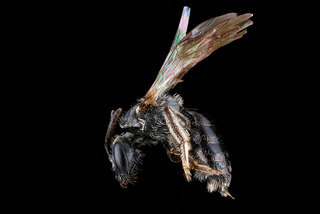
© Copyright source/photographer
· 9
Lasioglossum foxii, -unkown, -side 2012-07-17-16.47.23 |
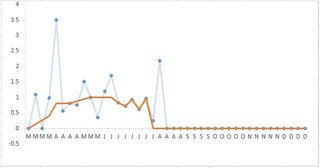
© Copyright source/photographer
· 9
Lasioglossum foxii, Mid-Atlantic Phenology |
|
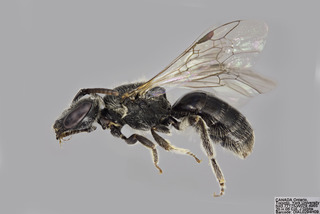
© Copyright Laurence Packer 2014
· 7
Lasioglossum foxii FEM CFP comp |
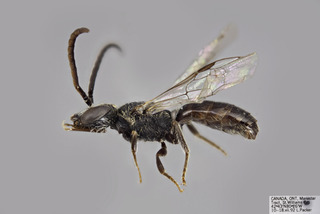
© Copyright Laurence Packer 2014
· 7
Lasioglossum foxii MALE CFP comp |
|
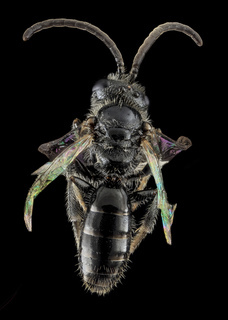
© Copyright source/photographer
· 5
Lasioglossum foxii, M, Back, Md, Baltimore Co |
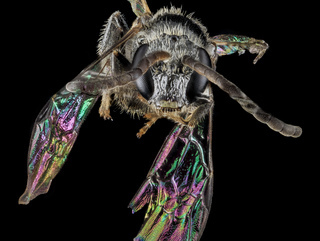
© Copyright source/photographer
· 5
Lasioglossum foxii, M, Face, MD, Baltimore Co |
|
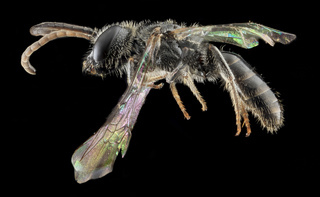
© Copyright source/photographer
· 5
Lasioglossum foxii, M, Side, MD, Baltimore Co |
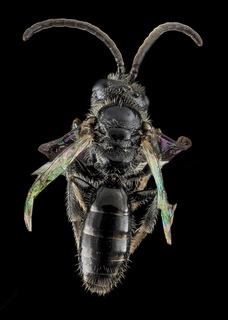
© Copyright source/photographer
· 5
Lasioglossum foxii, M, Back, Md, Baltimore Co |
|
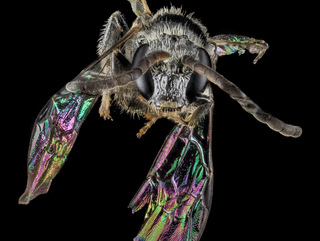
© Copyright source/photographer
· 5
Lasioglossum foxii, M, Face, MD, Baltimore Co |
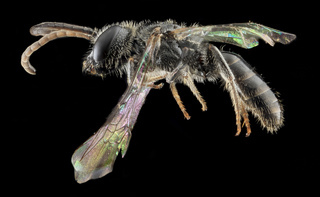
© Copyright source/photographer
· 5
Lasioglossum foxii, M, Side, MD, Baltimore Co |
|
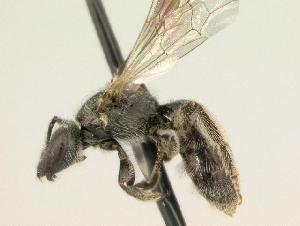
Barcode of Life Data Systems · 1
Lasioglossum foxii, Barcode of Life Data Systems |
|
Overview |
Reprinted with permission from: Mitchell, T.B. 1960 Bees of the Eastern United States. North Carolina Agricultural Experiment Station Technical Bulletin No. 141.
FEMALE�Length 6-7 mm.; black; pubescence whitish, very short and thin; head very slightly longer than broad; clypeus slightly convex, projecting nearly two-thirds below suborbital line; eyes converging below; cheeks slightly narrower than eyes; lateral ocelli much nearer margin of vertex than to eyes; face above antennae dull, densely rugoso-punctate, more shining below, punctures distinctly separate but not sparse, close on upper portion of clypeus, becoming much more coarse and sparse apically; area between eyes and ocelli shining, punctures very fine and distinct, vertex medially dull, finely and obscurely striate, cheeks more shining, very minutely and obscurely punctate above, becoming substriate below; scutum shining, punctures deep, distinct and rather close, those on median area becoming somewhat finer and closer laterally; scutellum shining, very sparsely punctate on each side of a median, more closely punctate impression; pleura smooth, somewhat shining, with scattered, obscure punctures; dorsal area of propodeum with a basal fringe of short striae, smooth and rounded apically, posterior face rather dull, very minutely substriate, lateral carinae strongly divergent, very short; wings subhyaline, veins and stigma brownish-testaceous; tegulae reddish-piceous, with a narrow, hyaline, anterior rim; legs dark, becoming more or less reddened apically; hind basitibial plate rather obscure, obliquely truncate apically; abdominal terga somewhat shining, very minutely and obscurely punctate, punctures on basal tergum rather close in median area of disc, but very sparse basally and apically, those on second and following terga progressively more minute and obscure, basal fasciae of terga 2 and 3 evident laterally, discal pubescence extremely short and thin, entirely pale.
MALE�Length 5-6 mm.; black, including labrum and legs in large part, clypeus more or less yellowish apically and mandibles and tarsi yellow at least in part; head considerably longer than broad; clypeus narrow, protuberant, projecting fully two-thirds below suborbital line; eyes convergent below; mandibles simple, rather short; labrum transverse, apical margin not angulate; cheeks narrower than eyes; lateral ocelli slightly nearer margin of vertex than to eyes; basal segment of flagellum very slightly longer than pedicel and slightly broader than long, the 2nd and following segments fully twice this length, brownish-testaceous below, piceous above; face above antennae dull, densely and finely rugose, lower portion more shining, with fine but distinct punctures largely obscured by dense, pale tomentum; area between eyes and ocelli rather dull, with minute, rather close and obscure punctures; vertex medially dull, obscurely roughened, cheeks more shining, punctures above very minute and obscure, hardly evident, becoming very finely substriate below; scutum shining, very finely punctate, punctures rather widely separated in central area of disc and only slightly closer at extreme sides, surface rather dull along anterior margin; scutellum polished, very sparsely and minutely punctate; pleura dull, very finely rugose anteriorly, becoming quite smooth and obscurely punctate posteriorly; dorsal area of propodeum with a basal fringe of short striae, but these complete laterally, becoming quite smooth and obscurely and minutely punctate, lateral carinae hardly evident; wings hyaline, veins and stigma brownish-piceous; tegulae shining, yellowishhyaline with dark blotches, anterior rim more distinctly hyaline; legs dark, apical tarsal segments becoming more or less yellowish; abdominal terga shining, punctures minute but quite distinct, well separated but not sparse on the more basal terga, becoming exceedingly minute and indistinct on terga 3-5, basal fasciae hardly evident; apical margin of sternum 5 straight, 6 broadly rounded; gonostylus short, quite narrow, clothed with inconspicuous, short setae, ventral, retrorse lobe quite short, very slender, with a slightly dilated base, partially clothed with very fine, short pubescence.
DISTRIBUTION�Nova Scotia to Manitoba and Minnesota, south to Georgia; April to September.
FLOWER RECORDS�Acer, Amelanchier, Apocynum, Barbarea, Brassica, Houstonia purpurea, Hydrangea, Malus, Malilotus, Potentilla, Rhus, Rubus, Taraxacum and Vicia. Robertson (1929) records foxii on the following additional genera: Antennaria, Arabis, Aruneus, Aster, Caealia, Capsella, Claytonia, Coreopsis, Cornus, Cryptotaenia, Dent aria, Erigenia, Geum, Isopyrum, Ozalis, Rhamnus, Ribes, Salix, Sanguinaria, Sanieula, Stellaria, Symphoriearpus, Taenidia, Viburnum, Viola, Zanthoxylum and Zizia. It is recorded by Brittain and Newton (1933-34) also on Aralia, Cirsium, Diervilla, Phleum, Rhododendron, Solidago, Trifolium and Vaccinium.
|
|
|
Identification | |
The lack or striations or reticulations going to the rim distinguish both the male and female of this species from the similar but more northern L. rufitarse. The rim of the propodeal triangle noticably smooth in both sexes.
Extracted from: Gibbs, J., Packer, L., Dumesh, S. and Danforth, B. N. 2013. Revision and reclassification of Lasioglossum (Evylaeus), L. (Hemihalictus) and L. (Sphecodogastra) in eastern North America (Hymenoptera: Apoidea: Halicidae). Zootaxa 3672 (1). Pp 1-116.
Diagnosis. Both sexes of L. foxii can be recognised by the combination of head long (L/W ratio = 1.03–1.10) (Figs.
4C, 6C); mesepisternum finely rugulose (as in Fig. 76A); and metapostnotal rugae not reaching the smoothly
rounded posterior margin of dorsal surface (Fig. 82B). The most similar species in eastern North America is L.
inconditum, which has metapostnotal rugae reaching posterior margin in both sexes (Fig. 82C).
Redescription. FEMALE. Length 5.4–6.1 mm. Head length 1.57–1.74 mm. Head width 1.52–1.65 mm. Wing
length 4.3–4.9 mm. (n=5)
Colour. Head and mesosoma black. Antenna black, except ventral surface of flagellum reddish brown. Tegula
testaceous-reddish brown. Legs dark brown, except medio- and distitarsi reddish brown. Wing membrane hyaline,
faintly dusky. Pterostigma brown. Metasomal terga black-brown, apical margins pale brown
Structure. Head long (L/W ratio = 1.03–1.05). Clypeus ¾ below suborbital line. Eyes convergent below
(UOD:LOD = 1.08–1.15). Gena narrower than eye. Ocelli normal. Pronotum smoothly rounded. Protibial spur with
apical serrations as long as width of malus. Inner metatibial spur pectinate, teeth 3–4, basal teeth much longer than
width of rachis. Metapostnotum posterior margin smoothly rounded. Propodeal lateral carina not reaching dorsal
margin, oblique carina absent.
Surface sculpture. Supraclypeal area polished medially, punctures sparse (i=1–2d). Gena weakly imbricatelineolate, postgena imbricate. Mesoscutum imbricate; punctures dense laterally (i≤d), distinctly separated between
parapsidal lines (i=1–1.5d). Mesepisternum finely rugulose, imbricate ventrally. Metapostnotum carinate-rugose
basally, apical margin imbricate. Propodeum imbricate-tessellate. Metasomal terga polished; punctures dense,
obscure posteromedially.
Pubescence. Head and mesosoma with sparse plumose hairs. Metafemoral scopa with dense plumose hairs.
Metasomal terga with apical fimbriae very sparse. T1 with sparse, erect plumose hairs. Metasomal sterna with
plumose scopa.
MALE. Length 4.4–6.0 mm. Head length 1.40–1.56 mm. Head width 1.27–1.45 mm. Wing length 3.5–4.4
mm. (n=5)
Colour. Head and mesosoma black. Clypeus yellow distally. Mandible brown basally, yellow apically. Labrum
yellow. Antenna black, except ventral surface of flagellum reddish brown. Legs dark brown, except tarsi, bases and
apices of tibiae testaceous-pale brown. Wing membrane hyaline. Pterostigma orange-brown. Metasomal terga dark
brown
Structure. Head long (L/W ratio = 1.05–1.10). Mandible short, reaching opposing clypeal angle.
Flagellomeres, except F1 elongate, F2 longer than F1 and pedicel combined, subequal to scape. Eyes convergent
below (UOD:LOD = 1.48–1.57). Gena narrower than eye. Pronotum smoothly rounded. Propodeal lateral carina
reaching less than half distance to dorsolateral slope.
Surface sculpture. Supraclypeal area polished medially, punctures relatively dense (i=1–1.5d). Gena lineolate,
postgena imbricate. Mesoscutum weakly imbricate, polished posteromedially; punctures moderately dense
laterally (i=1–2d), clearly separated between parapsidal lines (i=1–2.5d). Mesepisternum weakly rugulose,
imbricate ventrally. Metapostnotum carinate-rugose, apical margin imbricate. Propodeum weakly rugulose
laterally, posterior surface weakly imbricate. Metasomal terga polished, apical impressed areas weakly coriarious;
punctures deep, close basally. T3–T6 apical impressed areas impunctate.
Pubescence. Head and mesosoma with sparse plumose hairs. Metafemoral scopa with dense plumose hairs.
Metasomal terga with apical fimbriae very sparse. T1 with sparse, erect plumose hairs. Metasomal sterna with
plumose scopa.
MALE. Length 4.4–6.0 mm. Head length 1.40–1.56 mm. Head width 1.27–1.45 mm. Wing length 3.5–4.4
mm. (n=5)
Colour. Head and mesosoma black. Clypeus yellow distally. Mandible brown basally, yellow apically. Labrum
yellow. Antenna black, except ventral surface of flagellum reddish brown. Legs dark brown, except tarsi, bases and
apices of tibiae testaceous-pale brown. Wing membrane hyaline. Pterostigma orange-brown. Metasomal terga dark
brown.
Structure. Head long (L/W ratio = 1.05–1.10). Mandible short, reaching opposing clypeal angle.
Flagellomeres, except F1 elongate, F2 longer than F1 and pedicel combined, subequal to scape. Eyes convergent
below (UOD:LOD = 1.48–1.57). Gena narrower than eye. Pronotum smoothly rounded. Propodeal lateral carina
reaching less than half distance to dorsolateral slope.
Surface sculpture. Supraclypeal area polished medially, punctures relatively dense (i=1–1.5d). Gena lineolate,
postgena imbricate. Mesoscutum weakly imbricate, polished posteromedially; punctures moderately dense
laterally (i=1–2d), clearly separated between parapsidal lines (i=1–2.5d). Mesepisternum weakly rugulose,
imbricate ventrally. Metapostnotum carinate-rugose, apical margin imbricate. Propodeum weakly rugulose
laterally, posterior surface weakly imbricate. Metasomal terga polished, apical impressed areas weakly coriarious;
punctures deep, close basally. T3–T6 apical impressed areas impunctate.
Pubescence. Head and mesosoma with sparse plumose hairs. Paraocular area below eye emargination with
dense tomentum. Propodeum largely bare, with scattered plumose hairs. Metasomal terga nearly bare, apical
fimbriae extremely sparse. Metasomal sterna with sparse, plumose hairs (1.5–2 OD).
|
|
|
Names | |
|
|
| Supported by | |
Updated: 2024-04-26 01:17:30 gmt
|